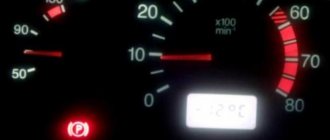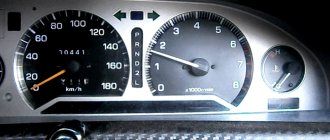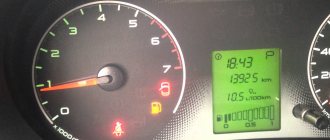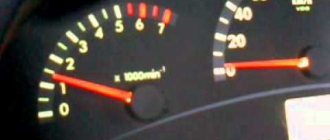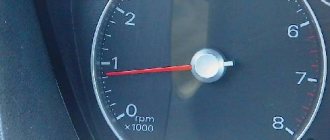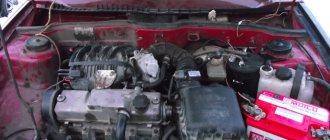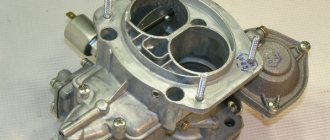You rarely see imported components on domestic cars. Basically, AvtoVAZ engines are equipped with a Solex or Ozone carburetor. Less often you can find products from the Dimitrovgrad Aggregate Plant, known for its reliability: the DAAZ carburetor. Drivers of relatively modern cars, accustomed to the check engine light, can easily determine any malfunction using an on-board computer or an inexpensive car scanner, but for veteran engine owners, only hardware diagnostics are available.
A common malfunction is idle speed floating, the main symptoms are:
- It would seem that the problem does not affect the speed - with intensive use of the gas pedal, the malfunction is invisible. However, it is dangerous in traffic jams, when the engine may suddenly stall, and when engine braking on a long descent;
- In addition, increased vibrations do not add life to the motor and attachments. Bearings of rotating shafts experience axial loads that are not typical for them. And it is uncomfortable for passengers to be in the car when the tachometer needle jumps from 500 to 1500 rpm.
The driver is forced to constantly apply gas, this distracts from the road and increases gas consumption.
So, manifestations of floating idle:
- The tachometer needle moves smoothly or sharply in the range of 1000 revolutions;
- The car shakes noticeably: there is always a feeling that it will stall;
- Pops of unburned fuel in the muffler and under the hood. In the first case, the mixture is rich, in the second, it is lean;
- Vibrations similar to tripping (at the same time you are sure that the spark plugs and the high-voltage part of the ignition system are in good condition);
- The motor randomly picks up speed, then smoothly reduces it. The problem is non-linear, it suddenly appears and also disappears suddenly (this somewhat complicates the diagnosis).
It is not difficult to localize the fault. If (we repeat: in the absence of other malfunctions), the speed fluctuates, look at the carburetor.
Let's list them.
- The most basic is a malfunction or failure of the mass air flow sensor.
- No less common is the breakdown of the idle air control valve.
- A crankshaft position sensor providing incorrect information to the control unit can also be the root cause of a high or floating idle.
- The throttle position sensor may also be to blame.
- It happens that for some reason the gas pedal does not return all the way back. Moreover, this happens both because of a banal malfunction of the cable, and because of something completely ridiculous - for example, after washing the car, they covered the driver’s mat in such a way that the tip of the mat began to touch the pedal.
- The air filter is very clogged. Because of this, the combustion mixture is too rich in gasoline, again resulting in high idle speeds.
- The cable came off the throttle valve.
- Engine temperature sensor faulty. It gives the car’s “brains” incorrect values, which increase the crankshaft speed, thinking that the engine is cold.
As you can see, we have before us a whole forest of very different reasons why high revs appear! Next, we will take a closer look at the most typical, plus the most common problems associated with the problem described. At the same time, we’ll figure out how to eliminate them with our own hands.
Ways to eliminate the “sore”
If such a problem occurs, you need to look for which node is to blame analytically, checking all the specified sensors
First, let's consider the following option for correcting the problem situation. Let's assume that a VAZ 2110 has high revs. An examination of the suspected components for faulty components showed that the throttle position sensor has traces of rust. It is located directly above the throttle valve. Measurements with a voltmeter showed that when the engine is idling, the voltage on it remains high - which means it does not close the damper.
How to fix the problem? For this we only need a screwdriver. Let's begin the procedure.
- By disconnecting the terminal block and also unscrewing two screws, we dismantle the assembly. We notice that traces of rust inside interfere with the movement of the wheel that regulates the position of the damper.
- We fill the insides of the defective device with a penetrating anti-rust aerosol.
- Use a development screwdriver to turn the wheel.
- We reassemble in reverse order.
Check to see if the engine idle speed is now high. The problem should go away.
Now let's look at another case. Let's say we have high idle speed in a VAZ 2114. This is what we do when faced with this situation.
When clarifying the circumstances of the problem under investigation, we always initially check the operation of the idle speed sensor. This device consists of a needle built inside an electromagnetic coil. The needle either moves inside the coil, moving away from the hole in the throttle pipe, or moves out, closing this hole, thereby stopping the supply of air for combustion of the mixture.
This element is located at the throttle valve, opposite the gas pedal cable. To diagnose it, we pull out the terminal block from it, start the car, after which we see that we still have high engine speeds that have not changed at idle. Then we remove this defective unit, then clean it or replace it. For work we take:
Carburetor engine "nine"
If the speed of the VAZ 2109 carburetor fluctuates and you are adjusting the idle speed of the car in your own garage, in the yard of your house, and are not in a hurry, you can try to understand why the speed is floating and adjust the carburetor with your own hands. You will need a slotted screwdriver.
The procedure is as follows.
- Warm up the engine to operating temperature of 90 degrees.
- Set the quality screw to the original position for adjustment. To do this, screw it all the way and unscrew it back 6 turns.
- Set the quantity screw to the initial position for adjustment. To do this, screw it all the way and unscrew it back one and a half turns.
- Start the engine.
- If the engine speed exceeds 800 rpm, turn out the speed screw and bring it to 800.
- By turning the quality screw clockwise and counterclockwise, select its position in the middle of the engine’s stable operation zone.
- By turning the quantity screw, bring the crankshaft speed to 900 rpm.
If the idle speed of the "nine" began to float while you were on the road, it is better not to try to adjust the carburetor in the field. Pull the choke control lever towards you to slightly increase the idle speed. The car will not stall while driving. Fuel consumption will increase slightly, but you will have to put up with this in order to get to the service center without any problems.
Often the cause of fluctuations in idle speed is increased play in the rotating parts of the distributor. This problem cannot be fixed by yourself. The distributor will have to be changed.
If the idle speed of a VAZ 2109 (carburetor) fluctuates?
The first thing that the owner of a VAZ 2109 car who is faced with such a problem should know is that the carburetor itself is not always to blame. It may turn out that the ignition system or power system is faulty. Problems usually start when the car is warm. And here the reasons are the same for Ozone, Solex and others.
Let's start with the main known symptoms of this idle problem.
- VAZ 2109 carburetor idle speed floats;
- individual popping sounds are heard in the muffler or carburetor;
- there are gaps during operation of the engine cylinders;
- The speed changes, sometimes up, sometimes down.
Causes of the “disease” and ways to eliminate them:
- Firstly, the problem may be due to the fact that the VAZ 2109 carburetor was adjusted incorrectly. Usually - towards a leaner combustible mixture. This misunderstanding can be eliminated simply - with the help of “quality” and “quantity” screws. This has already been discussed in the article.
- The second common cause is a faulty solenoid valve. If the valve is faulty, the flow of fuel into the idle system is blocked. If, while the engine is running, you quickly remove and put the wire back on the valve, you should hear a click. This indicates that the valve is in working order. If this is not the case (there was a click), then we check the forced idle economizer system itself.
- The third problem is dirt getting into the jets and channels in the idle system. They can be blown out under pressure by first placing a certain amount of cleaner in the valve hole.
- Excess air enters the fuel mixture. "Suction." This usually causes the car engine to “trouble.” There is a video on this topic: it explains in detail what it is and how to deal with it.
- The fuel level in the float chamber is too high or too low. To do this you need to adjust it. You can find out more about this here:
- If you have checked all these options, but your VAZ 2109 (carburetor) still idles, then you need to check whether the VAZ 2109 (carburetor) air filter is clogged.
Air filter for a VAZ 2109 car with a carburetor engine:
Similar malfunctions on Samara can occur both during improper operation and as a result of exposure to unfavorable conditions, including weather, humidity, and temperature.
Checking all variants of the malfunction that led to floating speed should be carried out by professionals. If you have difficulties with diagnostics, it is best to seek advice and repair from a car service center.
Carry out diagnostics in a timely manner, and adjusting the VAZ 2109 carburetor is a mandatory procedure even for those cars that were recently purchased.
If you carry out the check in a timely manner, then you may not need such an unpleasant procedure as repairing a VAZ 2109 carburetor.
Be careful in all actions you perform during the inspection. Some parts can be easily damaged - follow the instructions strictly.
And finally, the most visual video about the situation when the idle speed of a VAZ 2109 (carburetor) fluctuates:
You can also read on this topic:
Car gearbox and its purpose
Which xenon is best to install on your car?
Tuning a VAZ 2115 with your own hands is impressive
Still dreaming of big wheels?
How to increase the power of a VAZ 2109 engine (carburetor) with your own hands
Alex S January 10, 2014
Published in: Useful tips and car devices
Tags: Advice for motorists
Functions
The IAC regulates the amount of air entering the engine when the throttle valve is closed. This suggests that the IAC performs the functions of automatically adjusting the specified engine speed when idling.
The regulator also takes part in the process of warming up the engine to optimal operating temperatures in winter. The operating temperature range of the IAC is quite wide - from -40 to +130 degrees Celsius.
The IAC, despite such important functions, is small in size and consists of three main elements:
- Stepper electric motor;
- Spring;
- A rod with a cone-shaped needle at the end.
The idle speed control is mounted on the throttle body with a pair of screws.
IAC location
A little history
Despite the fact that the model seems old, its release was planned in March 1990, but happened a little later. In December 1990, the VAZ-21099 began to be produced in large series. The Ukrainian plant assembled this car until 2011 from Russian special vehicle kits.
The version from Ukraine had a slightly different name - ZAZ-21099. VAZ-21099 was produced under various names. They all differed in interior, details, year of production and country of assembly. Export names of VAZ-21099:
- Saloon
- Lada Samara
- Lada Sable
- Lada Sagona
- Lada Forma
- Lada Victory
All these cars had the common name “Samara”. But the VAZ-21099 had significant differences from everyone else.
- The front part of the body had long wings.
- Longer hood.
- No plastic “beak” at the front.
- New radiator grille.
- The instrument panel is gray (in other models the dominant color is brown).
This is how people of that time remember this car. But in 2004, the VAZ-21099 was completely discontinued at AvtoVAZ and replaced. Instead of the old, well-known model, the VAZ-2115 appeared. This is what made Ukrainian collectors continue to collect the legend. However, in 2011 this car was discontinued in all countries.
Together with it, they stopped producing the VAZ-21093. VAZ-21099 Victory is considered the most advanced model. Its most important advantage is that it had standard machine parameters (4x4). However, it has only a few improvements from the old model. Added.
- Rear axle gearbox from Volkswagen Golf Syncro.
- Viscous coupling.
- Angular gearbox.
- Transmission.
Victory is also distinguished by incredible dynamics, since the engine is forced. Its cross-country ability met all standards, which was perfectly possible with all-wheel drive. But times have passed, and the model has not received wide recognition. Therefore, the enterprise soon ceased its work.
Many people today prefer this car for two simple reasons.
- In terms of price, it is much cheaper than modern foreign cars, easy to maintain, and has inexpensive spare parts.
- Patriotism and the desire to preserve the legend.
But despite the fact that the reasons are compelling, and the car is of really good quality, times have taken their toll, and therefore, no matter how much one would like to admit it, the car is capable of breakdown. The carburetor is the first to suffer.
Signs of malfunctions
It should be noted that it is difficult to successfully resolve this situation without making the correct “diagnosis”. It is important to check all working components of the motor.
The following symptoms indicate poor carburetor performance:
- The Lada engine speed drops on its own, resulting in an unreasonable increase.
- There are gaps in the functioning of the cylinders.
- In the area of the carburetor and muffler, sharp pops periodically occur.
- At idle, the number of rotations is unstable, they have fallen.
The reasons for the drop in rotation at idle solex appear due to violations of the operating conditions of the vehicle. The manufacturer determines the rules for using the vehicle. Often, problems with the carburetor (idles float) are a consequence of unfavorable climate conditions (high humidity levels, high temperatures, changes). Do not forget to check the engine's performance in a timely manner.
Unstable idling of the engine with carburetor 2108 Solex and 2105, 2107 Ozone
Unstable idling of a car engine with a carburetor 2108, 21081, 21083 Solex or 2105, 2107 Ozone is one of the most common malfunctions. In addition to the discomfort of operating a car with a shaking engine that is about to stall, a car owner faced with such a problem must be prepared for a rapid decrease in its service life, an increase in fuel appetite, loss of power, throttle response, etc. It should immediately be noted that these reasons typical for a warm car engine idling with the choke fully open and the throttle closed. Unstable engine operation in other modes may have other reasons and will be discussed in a separate article.
— The engine is unstable at idle. It vibrates, “troits”, there may be popping noises in the muffler or carburetor. You can hear cylinder misfires and possible black smoke from the muffler. Shooting at the muffler indicates that the fuel mixture is too rich at idle, and shooting at the carburetor indicates that it is too lean. An over-rich or over-lean fuel mixture entering the engine cylinders at idle is at the root of all the causes of unstable idle speed. This is what we will start from when diagnosing and eliminating this malfunction.
— Idle speed spontaneously, then decreases, then increases (“floats”). Typically, this phenomenon is observed when a separate piece of debris gets into the channels or jets of the CXX or the “suction” of foreign air into the carburetor. Periods of deterioration in idle performance may alternate with periods of stable operation. As a bonus, glow ignition can be added to unstable idle speeds - that is, the engine continues to run for some time after the ignition is turned off.
Causes of unstable idle
The engine idle speed control is broken
Most likely, for some reason the adjustment was made towards a leaner fuel mixture at idle. Adjust the idle speed using the “quantity” and “quality” screws of the fuel mixture, available on both the Solex and Ozone carburetors. For 2108, 21081, 21083 Solex normal idle speed is 750-800 rpm, for 2105, 2107 Ozone 850-900 rpm.
adjusting screws for the “quantity” and “quality” of the fuel mixture of carburetors 2108, 21081, 21083 Solex, 2105, 2107 Ozone
How to correctly and quickly adjust idle speed is described in the articles:
Carburetor solenoid valve faulty
The valve itself or the EPH system is faulty. If the valve fails completely, its needle will block the hole for supplying fuel to the idle system, and the engine will stall. At idle, it will only operate with the choke pulled out. If the solenoid valve shows signs of life, then idling is possible, but it will be unstable.
Procedure: from simple to complex
The simplest solution is to sell the car. Maybe this is the best decision. When your car has a high mileage and service life, and you are not a professional auto mechanic, then there is no point in undertaking repairs. If you are not very strapped for money, if numerous “unreasonable” breakdowns occur, perhaps the best solution is to exchange the VAZ 2109 for a simple used foreign car or a new Lada.
But if you decide to tinker with your Samara and adjust the idle speed yourself, start with simple things. Inspect the electrical wiring, inspect the contacts, touch the connector pads. The causes of floating faults often lie in the vehicle's electrical wiring. It gets hot and dry - there is contact, gets wet and cools - there is no contact.
If, when moving the wires under the hood, a malfunction appears and disappears, start ringing the wires one by one. Particularly vulnerable in the “nines” is the harness that leads to the fuse box. It is located next to the drain coming from the windshield, and during precipitation it gets wet more intensely than others.
Among other simple things that can cause the 9's engine speed to fluctuate at idle is a clogged air filter. This applies to both carburetor and injection versions of the power plant. It's easy to check.
Remove the air filter from the preheated engine, leaving the carburetor inlet pipe freely open. Start the engine. If the speed stabilizes, change the air filter. If not, install the filter back and move on to further research.
Idling
Idling of a car is the operation of its engine when the gear is in neutral. At the same time, the fuel load, as well as the load on the engine, is minimal.
Idling is used in several cases:
- To “bleed” the oil after the car has been parked for a long time.
- To warm it up during cold weather.
- To keep the engine running for a long time without driving the vehicle.
Idling VAZ 2114
Engine idle operation looks like this: first, the speed quickly rises to 2,000 or even 2,500 rpm, after which it gradually decreases and stops around the 800 rpm mark.
This type of engine operation is absolutely normal. If, in idle mode, the VAZ 2114’s revolutions jump (either sharply increase or drop sharply, and the interval of “jumps” can be up to 1,500 rpm), then a malfunction has occurred in the engine system. In most cases, such a sharp fluctuation in speed leads to the engine stalling.
Clogging in a carburetor engine is the main cause of the problem.
If dirt is found in the carburetor engine, then the likelihood of malfunctions is high:
- Blockage in the area of the fuel and air jet of the cold running system. The failure can be eliminated by cleaning the fuel and air jets. To solve this problem, the carburetor cover is dismantled.
- Solex air valve is dirty. If the level of contamination is high, then it is appropriate to replace this element with a new one. The unstable motion will disappear, the swimming will disappear.
- There is a blockage in the fuel system filter. When a large amount of contaminants accumulates, an effect such as floating idle speed on a VAZ 2109 often occurs.
↑
VAZ 2109 carburetor floats speed while moving twitches
The idle speed (idle speed) of the carburetor engine of VAZ 2108, 2109, 21099 cars “floats” - that is, they drop almost to a complete stop (the engine “troits” or even “doubles”), then they rise to normal or even higher .
There are several reasons for “floating” idle speed. They are associated with a malfunction of the carburetor, the power system, the ignition system, and the engine itself.
They are based on either a disruption in the fuel supply to the engine or a failure in the operation of elements of the ignition system.
“- Suction” of foreign air into the carburetor
The culprits may be a hose from the vacuum brake booster to the intake manifold, rubber sealing rings on the “quality” screw and solenoid valve, a slipped or burst tube to the housing of the vacuum ignition timing regulator on the distributor, a leaky housing or a damaged diaphragm of the vacuum regulator housing, deformation of the seat carburetor surface, or wear of its gaskets, crankcase ventilation tube.
The “suction” causes the fuel mixture to become leaner and, as a result, the normal operation of the car engine at idle is disrupted. Read more about how to look for the cause of the “suction” on the page “Suction of foreign air into the carburetor.”
Places where air may leak into the carburetor
— The fuel and/or air jet of the Solex carburetor idle system is clogged
It is necessary to clean the fuel jet CXX located in the tip of the solenoid valve (EMV) and the air jet CXX.
Solex carburetor solenoid valve with fuel jet CXX
To clean the air jet, you will have to remove the carburetor cover. Read more: “Cleaning the idle system of a Solex carburetor.”
Air jet and air channel CXX Solex
— The forced idle system (EFS) or EMC is faulty
The carburetor solenoid valve (EMV) (see photo above) is part of the carburetor EPH system. If it fails, the valve needle may partially either close or open the hole in the CXX fuel nozzle, disrupting the passage of fuel into the engine through the idle system. A similar situation can arise if the valve itself fails or is installed incorrectly. See “Checking and repairing the EPH system of the Solex carburetor.”
The degree of contamination should be quite high. Replace it with a new one.
Engine air filter
— Ignition system elements are faulty
Most often, the culprit is a faulty spark plug. It is necessary to assess the condition of the spark plugs by their appearance and replace them with known good ones to check. In addition to spark plugs, “floating” idle speeds are possible due to a “breakdown” of the voltage wires, the cover and the distributor slider. ignition coil malfunction. For more details, see “Malfunctions of the contactless ignition system.”
— Fuel supply to the carburetor is interrupted
The fuel system filters (in the carburetor, fuel pump, fine filter and on the fuel intake in the tank) may be clogged, or the fuel line may be damaged. Also, operating a faulty fuel pump or with an out-of-adjustment drive will have a similar effect. Read more: “Malfunctions of the fuel supply system of a carburetor engine.”
Minimum adjustable pusher protrusion required for proper operation of the fuel pump
— The phases of the gas distribution mechanism are disrupted
Check the position of the timing marks of the timing gear drive. And also timing belt tension. A belt that has jumped a tooth or two causes a timing shift and disruption of the engine at idle.
Timing drive timing marks for carburetor engines of VAZ 2108, 2109, 21099 cars
Notes and additions
— Before you begin to identify the reasons for the appearance of floating engine idle speed, it is necessary to conduct a visual inspection of the engine compartment. A loose wire, a chip not fully inserted, a kinked hose, etc. will not allow the engine to work normally, and will take away time and effort spent on troubleshooting.
— The engine only runs on choke, why?
— VAZ car engines
— Increased oil consumption by carburetor engines of VAZ 2108, 2109, 21099 cars
— The engine overheats on VAZ 2108, 2109, 21099 cars
— Elimination of dips, jerks, twitches in the operation of carburetor engines of VAZ 2108, 2109, 21099, 2105, 2107 cars
— The engine of a car with a Solex carburetor lost idle speed, reasons
— The engine is shaking. causes of malfunction
— Floods spark plugs, causes of malfunction
Poor quality gasoline is harmful
Many problems when operating the propulsion system of a VAZ car are associated with the use of low-quality gasoline. Leftover gasoline at unreliable gas stations is very dangerous. The entire fuel line, carburetor, and possibly even the engine may need to be flushed. It is quite possible that the units will have to be disassembled, washed, soaked and blown with compressed air.
If circumstances force you to refuel in an unfamiliar place, use caution.
| What to worry about | What results will this give? |
| Try not to use fuel filled in a proven location until the tank is empty. | Let there be at least a mixture of good and risky fuel in the gas tank, and not just questionable fuel - this will reduce the risk. |
| Fill only the minimum amount of fuel. | One that will allow you to get to a proven gas station worthy of your trust. |
| On long trips, carry a cleaning additive with you to add to your gas tank. | It is likely that you will be able to get away with adding the appropriate additive to the fuel tank when using questionable gasoline. It's like getting a flu shot - it boosts your immunity. |
One gas station at an untested gas station, and you face the prospect of serious repair work.
Car chip tuning
Chip tuning - this word refers to the simple adjustment of the injector and electronic engine control system in order to improve its performance.
Firmware can prepare the car for the quality of local fuel, certain operating temperature conditions, and also determine exactly how much fuel the engine will consume in normal modes.
Advantages of chip tuning
Among the main advantages that a car receives after such modifications are:
- accelerated start from a place,
- smooth movement with minimal load,
- as well as the most even traction that occurs when working in the highest gears.
And, of course, if you are pursuing the goal of saving, you can significantly reduce fuel consumption. Depending on the car model and previous settings, consumption can be reduced by half a liter to three liters per hundred kilometers.
You can’t do without a special diagnostic program
However, it is recommended to carry out all settings only at a service center. As a rule, specialists from such service stations work only with proprietary software, and also install only those firmwares that have already been tested in real conditions. If the firmware is not of sufficient quality, then you will have to pay for the car’s sporting achievements.
This is what a set of diagnostic equipment looks like
Many motorists have experienced the effect of a drop in idle speed on their car. Often, this leads to the engine stalling altogether. This effect has many causes that need to be addressed urgently so as not to cause even bigger problems.
The VAZ engine does not work properly - why is repair needed?
Over time, almost every owner of a VAZ 2109 is faced with a problem such as a drop in engine speed at idle. Why can't I use a faulty machine? In this condition, operating the vehicle is problematic. At a traffic light, the car, when the speed drops, may suddenly stall or when the gear is engaged in neutral.
If such a situation arises, the VAZ driver must constantly support the car by pressing the gas pedal. This operation is performed so that the vehicle does not stall when the speed jumps at idle on the VAZ 2109 in the carburetor. When such a difficulty arises, the driver notices that the tachometer needle constantly symbolizes the presence of different revolutions. This figure ranges from
500-1200. The car is shaking, which additionally causes discomfort.
If you find that the idle speed of a VAZ 2109 in a Solex carburetor is floating, then you should not put off solving the problem. Due to such unstable functioning of the carburetor, other vehicle systems may also fail. And this will lead to the need for more expensive repairs.
Carburetor engine "nine"
If the speed of the VAZ 2109 carburetor fluctuates and you are adjusting the idle speed of the car in your own garage, in the yard of your house, and are not in a hurry, you can try to understand why the speed is floating and adjust the carburetor with your own hands. You will need a slotted screwdriver.
The procedure is as follows.
- Warm up the engine to operating temperature of 90 degrees.
- Set the quality screw to the original position for adjustment. To do this, screw it all the way and unscrew it back 6 turns.
- Set the quantity screw to the initial position for adjustment. To do this, screw it all the way and unscrew it back one and a half turns.
- Start the engine.
- If the engine speed exceeds 800 rpm, turn out the speed screw and bring it to 800.
- By turning the quality screw clockwise and counterclockwise, select its position in the middle of the engine’s stable operation zone.
- By turning the quantity screw, bring the crankshaft speed to 900 rpm.
If the idle speed of the "nine" began to float while you were on the road, it is better not to try to adjust the carburetor in the field. Pull the choke control lever towards you to slightly increase the idle speed. The car will not stall while driving. Fuel consumption will increase slightly, but you will have to put up with this in order to get to the service center without any problems.
Often the cause of fluctuations in idle speed is increased play in the rotating parts of the distributor. This problem cannot be fixed by yourself. The distributor will have to be changed.
Procedure: from simple to complex
The simplest solution is to sell the car. Maybe this is the best decision. When your car has a high mileage and service life, and you are not a professional auto mechanic, then there is no point in undertaking repairs. If you are not very strapped for money, if numerous “unreasonable” breakdowns occur, perhaps the best solution is to exchange the VAZ 2109 for a simple used foreign car or a new Lada.
But if you decide to tinker with your Samara and adjust the idle speed yourself, start with simple things. Inspect the electrical wiring, inspect the contacts, touch the connector pads. The causes of floating faults often lie in the vehicle's electrical wiring. It gets hot and dry - there is contact, gets wet and cools - there is no contact.
If, when moving the wires under the hood, a malfunction appears and disappears, start ringing the wires one by one. Particularly vulnerable in the “nines” is the harness that leads to the fuse box. It is located next to the drain coming from the windshield, and during precipitation it gets wet more intensely than others.
Among other simple things that can cause the 9's engine speed to fluctuate at idle is a clogged air filter. This applies to both carburetor and injection versions of the power plant. It's easy to check.
Remove the air filter from the preheated engine, leaving the carburetor inlet pipe freely open. Start the engine. If the speed stabilizes, change the air filter. If not, install the filter back and move on to further research.
